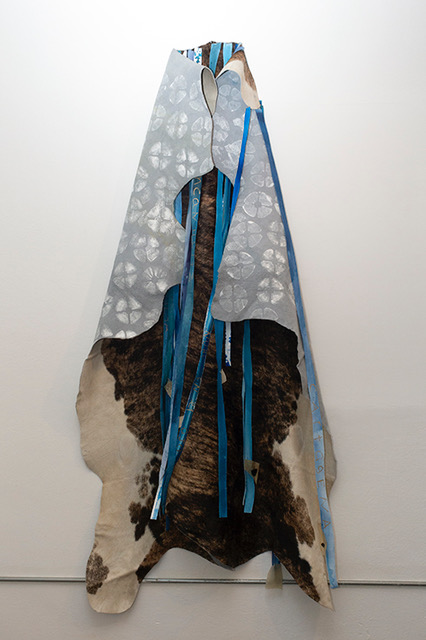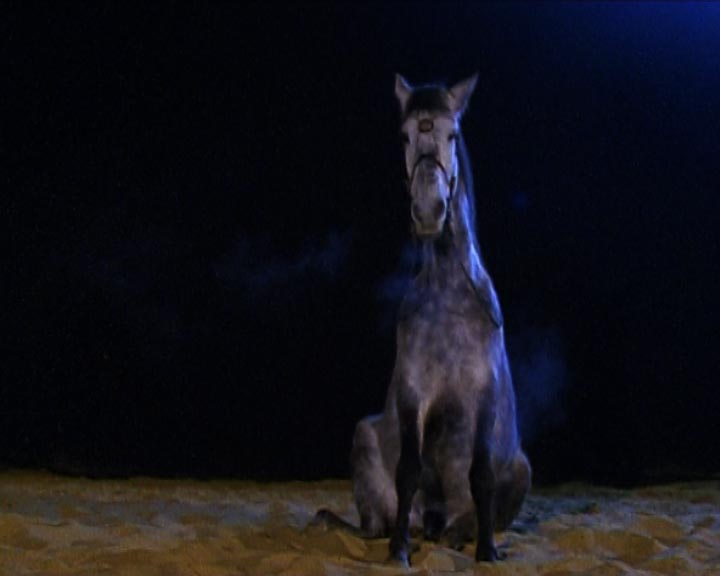
© » KADIST
Noé Martínez
As he investigates the forms that slavery took through different events that occurred during the sixteenth century in the Huasteca region of Mexico, Noé Martínez tells, in a non-linear narrative, the history of human trafficking in Relación de tráfico de personas 1525-1533 I (Study of Trafficking of Persons 1525–1533 I) . Both the departure of Huasteco Indians from the Americas, and the arrival of Africans from Cape Verde, Angola, Congo and Mozambique unravel in Martinez work as a story that has remained sealed in the colonial archives, and that continues under different guises in contemporary times. Relación de tráfico de personas 1525-1533 I is part of a series made of interventions in tanned leathers that refer to the exchange of human beings for pack animals and cattle in the Caribbean Sea.

© » KADIST
Adriana Martínez
Her 2015 work Orión is a black flag-like cloth with glow-in-the-dark symbols embroidered in the shape of the constellation. In the place of stars, Martínez has substituted the logos of international corporations and entities that use stars as their symbol; celestial navigation commanded by the logic of international corporations. Easily spotted is the smiling face of the Carl’s Jr. / Hardee’s logo, the three-pronged Mercedes-Benz emblem, Walmart’s six-pointed asterisk, and the starry cluster of the Subaru shield.

© » KADIST
Claudia Martínez Garay
escenario chacana by Claudia Martínez Garay is a sculptural work composed of a frame-like structure that contains a series of ceramic pieces. It references the Chakana, an Andean cross that encompasses the different levels of existence (known as Pachas) and sacred elements contained in the Indigenous cosmologies of the region. It often appears in the geometrical motifs of textiles and ceramics.

© » KADIST
Adriana Martínez
Her work Al final del arcoiris (At the end of the rainbow, 2015) is a bundle of bills from Chile, Venezuela, Brazil, Colombia, Nicaragua, and Costa Rica, arranged by color to form a tight spiraling rainbow held close with a rubber band. Here, Martinez uses these various currencies to gesture towards questions of capital and value, the accumulation of wealth, and regional economies. Beneath the surface of her playful visual propositions, Martinez asks us to consider not only the monetary costs of international goods, but also the real, human consequences of a global economic culture that privileges some and devastates others.

© » KADIST
Daniel Joseph Martinez
Martinez’s sculpture A meditation on the possibility… of romantic love or where you goin’ with that gun in your hand , Bobby Seale and Huey Newton discuss the relationship between expressionism and social reality in Hitler’s painting depicts the legendary Black Panther leaders Huey P. Newton and Bobby Seale. By using Carrara marble, a material usually associated with heroic public sculptures, Martinez casts the history of African-American revolutionaries into the artistic tradition of monumentality. Like the artist’s earlier work included in the 1993 Whitney Biennial, an interactive piece made up with pins that read, “I CAN’T IMAGINE EVER WANTING TO BE WHITE,” A meditation on the possibility… continues Martinez’s effort to expose cultural contradictions and increase public awareness.

© » KADIST
Carolina Saquel Martinez
The artist films a horse dressage session at night, in a dimly lit manège. In this video the artist recalls the importance of traditional equestrian portraits in Spanish painting and relates to the repetitive passage between the rider and the mount. This effect of repetition is accentuated by the video played in a loop and the fixed framing of the image shot from the ground, with body posture and dressage themes as a method for training and obedience.

© » KADIST
Daniel Joseph Martinez
For I use to eat lemon meringue pie till I overloaded on my pancreas with sugar and passed out; It seemed to be a natural response to a society of abundance (1978), also known as the Bodybuilder series, Martinez asked male bodybuilding competitors to pose in whatever position felt “most natural.” They are obviously trained in presenting their ambitiously carved physiques, but their facial expressions seem comparatively unstudied. Against a bare white background, the men appear unexpectedly vulnerable, caught between performance and rehearsal, public and private. While they present themselves deliberately as exemplars of strength, they also inadvertently expose something about the value system that underlies their endeavors—whatever drove them to keep building by tearing tissue, and whatever makes flexing feel like the most honest pose possible.

© » KADIST
Daniel Joseph Martinez
Drawing & Print (Drawing & Print)
If Only God Had Invented Coca Cola Sooner! Or, The Death of My Pet Monkey
Daniel Joseph Martinez
- location: Los Angeles, California
- year born: 1957
- gender: male
- nationality: American
- home town: Los Angeles, California
Carolina Saquel Martinez
Caroline Saquel was born in Chile and now lives and works in Paris...
-
1970-1979
Daniel Joseph Martinez
1978For I use to eat lemon meringue pie till I overloaded on my pancreas with sugar and passed out; It seemed to be a natural response to a society of abundance (1978), also known as the Bodybuilder series, Martinez asked male bodybuilding competitors to pose in whatever position felt “most natural.” They are obviously trained in presenting their ambitiously carved physiques, but their facial expressions seem comparatively unstudied...
-
2000-2009
Daniel Joseph Martinez
2005Martinez’s sculpture A meditation on the possibility… of romantic love or where you goin’ with that gun in your hand , Bobby Seale and Huey Newton discuss the relationship between expressionism and social reality in Hitler’s painting depicts the legendary Black Panther leaders Huey P...
-
2010-2019
Adriana Martínez
2015Her 2015 work Orión is a black flag-like cloth with glow-in-the-dark symbols embroidered in the shape of the constellation...
Adriana Martínez
2015Her work Al final del arcoiris (At the end of the rainbow, 2015) is a bundle of bills from Chile, Venezuela, Brazil, Colombia, Nicaragua, and Costa Rica, arranged by color to form a tight spiraling rainbow held close with a rubber band...
Noé Martínez
2019As he investigates the forms that slavery took through different events that occurred during the sixteenth century in the Huasteca region of Mexico, Noé Martínez tells, in a non-linear narrative, the history of human trafficking in Relación de tráfico de personas 1525-1533 I (Study of Trafficking of Persons 1525–1533 I) ...
Claudia Martínez Garay
2019escenario chacana by Claudia Martínez Garay is a sculptural work composed of a frame-like structure that contains a series of ceramic pieces...